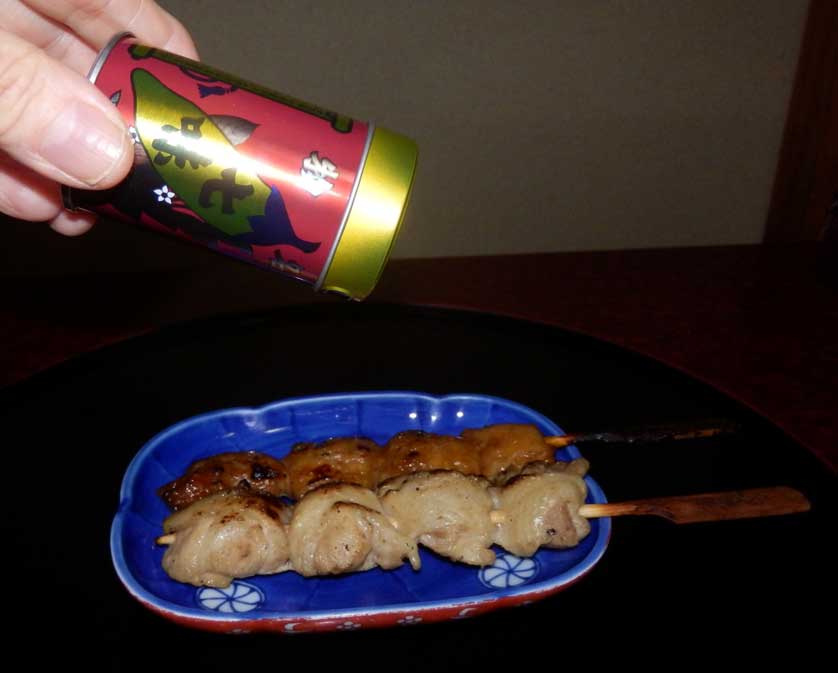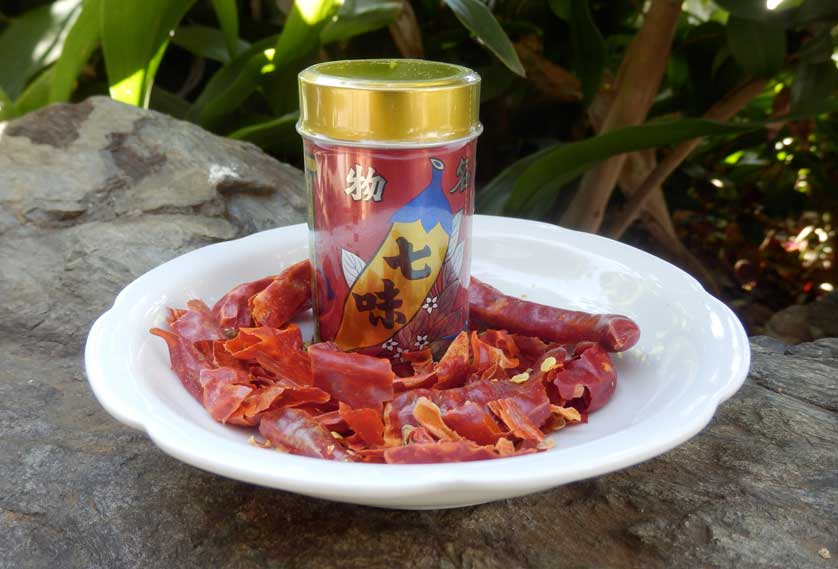Shichimi Togarashi - The Seven Spices Blend 七味唐辛子
 |
| Traditional Shichimi Togarashi merchant in Kawagoe |
by Johannes Schonherr
Literally translated, Shichimi Togarashi means seven-flavor chili pepper. Ground red chili pepper is the basic ingredient of any Shichimi Togarashi, making the spice blend spicy.
Another typical ingredient is sansho (Japanese mountain pepper, closely related to Szechuan pepper) which is spicy as well. The other spices in the mix however are purely added for flavor and fragrance. They commonly include sesame seeds, hemp seeds and chenpi (sun-dried mandarin orange peel) though each merchant has his own recipe.
 |
| Spice palette of a Shichimi Togarashi merchant |
Use of the Spice
Shichimi Togarashi is a standard condiment offered and much used in udon and soba noodle restaurants as well as in Japanese eel and yakitori restaurants. It also belongs on every Japanese kitchen table for a multitude of purposes ranging from livening up home-cooked soups to hot cheese sandwiches.
 |
| Shichimi Togarashi in use on yakitori |
Traditional Purchase
The best way to buy Shichimi Togarashi is purchasing it from a spice merchant near a popular temple or in a busy traditional area such as Tokyo's Asakusa or the historical Koedo (Little Edo) district in the center of Kawagoe, Saitama.
The merchant has the ingredients lined up right in front of the customer, he also provides a chart that indicates the spiciness of the mix - it ranges from "mild" to "extremely spicy". Most customers opt for somewhere in the middle. Often, additional spices, like the very popular dried yuzu peel are also available and can be added on customer's demand.
You then see the merchant mixing the spices exactly to your specifications and fill it into the typical Shichimi Togarashi container. That's a small metal can, with a hole on its upper end. The lid has a hole the same size. When using the spice, you turn the two holes to match and, with light shaking, dust the pepper over your meal. Then, you twist the lid again and thus seal the hole tight. The spices inside stay dry that way - even in the midst of the humid rainy season.
 |
| Yawataya Isogoro Shichimi Togarashi and dried chili pepper |
History of the Spice Blend
Red chili pepper originates from Central and South America, Portuguese missionaries brought the plant to Kyushu in the late 16th century. From there, the pepper spread quickly throughout Japan. Already during the 17th century, herb dealers in Edo (today's Tokyo) included chili pepper into their spice mixes, starting the tradition of Shichimi Togarashi.
Three main versions of Shichimi Togarashi developed, all linked closely to their places of origin: Yagenbori, sold in the vicinity of Sosenji Temple in today's Asakusa district of Tokyo, Shichimiya, sold on the streets leading to Kiyomizudera Temple in Kyoto and Yawataya Isogoro, produced and sold near Zenkoji Temple in Nagano.
 |
| Yawataya Isogoro Shichimi Togarashi |
Yawataya Isogoro Shichimi Togarashi
In Edo times, Nagano City was famous for its hemp products as well as for its Japanese washi paper. Traders from Nagano traveled to Edo and other places all over Japan to sell their wares. On their way home, they brought products acquired along the way back to Nagano.
One such trader, a man named Kan'emon, specialized in bringing Shichimi Togarashi on his return trips to Nagano. He soon realized, however, that Shinchu, as the Nagano area was known at the time, offered all the necessary ingredients to produce Shichimi Togarashi right there - with one exception, chenpi (mandarine-orange peel).
Sourcing the orange peel from Kansai, Kan'emon set up his own Shichimi Togarashi shop close to Zenkoji Temple in 1736, thus starting the still operating Yawataya Isogoro Company.
 |
| Yawataya Isogoro Shichimi Togarashi |
Available at Goods from Japan
Yawataya Isogoro Shichimi Togarashi is available in the food section at Goods from Japan. It comes in the classic metal container described above, one container carrying 14g of the spice blend. It's medium spicy and consists of this traditional mix: red chili pepper, chenpi, sesame seeds, hemp seeds, shiso (perilla), sansho (Japanese Mountain Pepper), and ginger.
Hemp seed may not be legal in all jurisdictions. Please check before you order.
Related
Furikake Tsukudani Rice Topping Kinshobai
Japanese Mortar & Pestle Suribachi & Surikogi
© GoodsFromJapan

No comments:
Post a Comment